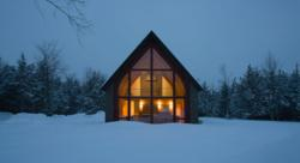The first certified Passive House constructed in New York State utilized Neopor (expandable polystyrene) supplied by BASF. Dennis Wedlick Architect (DWA) has designed the three-bedroom house. The Hudson Passive Project is one among the ultimate energy-efficient houses in the country.
 A departure from the modern Passive House aesthetic, Wedlick’s goal was to design a high-performance home with the rustic charm of a country barn. Photo by Elliott Kaufman.
A departure from the modern Passive House aesthetic, Wedlick’s goal was to design a high-performance home with the rustic charm of a country barn. Photo by Elliott Kaufman.
The construction has become the first in New York State to incorporate and attain the set tough standards recognized by Germany located Passive House Institute. The institute has gathered data that equates the energy ratings of various homes. The data informs that right implementation of Passive House design features will assist in achieving 90% reduced energy consumption.
Some of the innovative designs found in the project include daylighting technique incorporating skylighting features, and windows that faced the south side along with top performance providing seamless building envelop facilities. The house achieves almost nil energy consumption and does not use any type of auxiliary power facility.
The DWA in addition to including all the innovations in its design tried for a fitting insulating product that could provide an insulating rating of R-50 and R-60 for the base. The standard was vital to enable the house to utilize solar heat and at the same time retake the heat generated by the appliances used. DWA chose structural insulated panels (SIPs) from Cambridge, NY, located Timberline Panel Company, and optimized them with insulated panels supplied by Opco by utilizing Neopor beads provided by BASF. The graphite particles in the Neopor replicate and suck up thermal radiation. The use of the material while minimizing heat loss improved insulation capability. Also the SIPs with Neopor while cutting down the use of EPS raw materials by 50% to attain the same insulation operation managed a 20% thinner core when compared to that of traditional EPS.
Neopor is also utilized in other Passive House Projects in France, Switzerland and Germany.
Source: http://www.basf.com